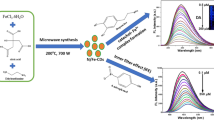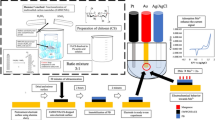Abstract
Dopamine (DA) is an important neurotransmitter in the human body, and a subnormal level is associated with some neurological problems, such as Alzheimer’s and Parkinson’s diseases. Its use as medicine has progressively increased, as well as its appearance in water bodies, such as domestic or hospital effluents. Dopamine has been found to produce neurological and cardiac damage to the animals that have consumed water with its content, so the removal of dopamine from water is of utmost importance to ensure water safety. Advanced oxidative processes (AOPs) are one of the most effective technologies to eliminate hazardous and toxic compounds in wastewater. In this work, Fe-based multi-walled carbon nanotubes (MWCNTs) were synthesized by aerosol-assisted catalytic chemical vapor deposition to be applied in the AOP of DA. MWCNTs (carbon nanotubes) exhibited high catalytic activity in removing DA with 99% of elimination.By increasing 4 times the initial concentration of DA, the removal percentage of the molecule was lower than the original one, which was attributed to the DA saturation of active sites. Even so, the percentage of degradation was high (76.2%).










Similar content being viewed by others
Data availability
Not applicable.
Change history
29 April 2023
A Correction to this paper has been published: https://doi.org/10.1007/s11356-023-27267-9
References
Alexander R, Prakash J, Kaushal A, Dasgupta K (2020) Confocal Raman Spectroscopy of Carbon Nanomaterials. Phys News 50:28–31
Anghel E, Simionescu OG, Pachiu C et al (2020) Preparation, raman spectroscopy and morphologycal analysis of vertically aligned graphene nanosheets. UPB Scientific Bulletin, Series b: Chemistry and Materials Science 82:181–190
Brillas E, Thiam A, Garcia-Segura S (2016) Incineration of acidic aqueous solutions of dopamine by electrochemical advanced oxidation processes with Pt and BDD anodes. J Electroanal Chem 775:189–197. https://doi.org/10.1016/j.jelechem.2016.04.054
Eghbalian M, Ansari R, Rouhi S (2021) Effects of geometrical parameters and functionalization percentage on the mechanical properties of oxygenated single-walled carbon nanotubes. J Mol Model 27:1–17. https://doi.org/10.1007/s00894-021-04946-3
Ericson JF, Laenge R, Sullivan DE (2002) Comment on “Pharmaceuticals, hormones, and other organic wastewater contaminants in U.S. streams, 1999–2000: a national reconnaissance.” Environ Sci Technol 36:1202–1211. https://doi.org/10.1021/es0200903
Escudero J, Muñoz JL, Morera-Herreras T et al (2021) Antipsychotics as environmental pollutants: an underrated threat? Sci Total Environ 769:144634. https://doi.org/10.1016/j.scitotenv.2020.144634
Frackowiak E, Béguin F (2001) Carbon materials for the electrochemical storage of energy in capacitors. Carbon 39:937–950. https://doi.org/10.1016/S0008-6223(00)00183-4
González-Davila M, Santana-Casiano JM, Millero FJ (2005) Oxidation of iron (II) nanomolar with H2O2 in seawater. Geochim Cosmochim Acta 69:83–93. https://doi.org/10.1016/j.gca.2004.05.043
Jiang D, Shi S, Zhang L et al (2013) Inhibition of the Fe(III)-catalyzed dopamine oxidation by ATP and its relevance to oxidative stress in Parkinson’s disease. ACS Chem Neurosci 4:1305–1313. https://doi.org/10.1021/cn400105d
Jimenez-Ramirez LE, Kashina S, Galindo R et al (2020) Synthesis, morphology, magnetic and electrochemical studies of nitrogen-doped multiwall carbon nanotubes fabricated using banded iron-formation as catalyst. Journal of Alloys and Compounds 835:155200. https://doi.org/10.1016/j.jallcom.2020.155200
Khan ZH, Husain M (2005) Carbon nanotube and its possible applications. Indian Journal of Engineering and Materials Sciences 12:529–551
Le Corre KS, Ort C, Kateley D et al (2012) Consumption-based approach for assessing the contribution of hospitals towards the load of pharmaceutical residues in municipal wastewater. Environ Int 45:99–111. https://doi.org/10.1016/j.envint.2012.03.008
Leon AL (2021) Materiales de carbonodopados con nitrógeno aplicados a la detección y oxidación catalítica de dopamina en medio líquido. Universidad de Guanajuato
Li M, Chen S, Li B et al (2021) Electrochimica Acta In situ growing N and O co-doped helical carbon nanotubes encapsulated with CoFe alloy as tri-functional electrocatalyst applied in Zn – Air Batteries driving Water Splitting. Electrochim Acta 388:138587. https://doi.org/10.1016/j.electacta.2021.138587
Lindberg RH, Östman M, Olofsson U et al (2014) Occurrence and behaviour of 105 active pharmaceutical ingredients in sewage waters of a municipal sewer collection system. Water Res 58:221–229. https://doi.org/10.1016/j.watres.2014.03.076
Mu E (2022) The Synthesis of Sponge-Type Nitrogen-Doped Multiwall Carbon Nanotubes Using Ball-Milled Natural Red-Leptosol as Catalyst Precursor : a Cycle Voltammetry Study. Carbon 196:510–524. https://doi.org/10.1016/j.carbon.2022.05.025
Santamaría Juárez GA, Gómez Barojas E, Quiroga-González E et al (2019) Preparation and characterization of reduced graphene oxide/titanium dioxide composites by hydrothermal method. Eur J Eng Res Sci 4:165–173. https://doi.org/10.24018/ejers.2019.4.9.1364
Speranza L, Di Porzio U, Viggiano D, et al (2021) Dopamine: the neuromodulator of long-term synaptic plasticity, reward and movement control. Cells 10:. https://doi.org/10.3390/cells10040735
Sun Y, Pham AN, Hare DJ, Waite TD (2018) Kinetic modeling of pH-dependent oxidation of dopamine by iron and its relevance to Parkinson’s disease. Front Neurosci 12:859. https://doi.org/10.3389/fnins.2018.00859
Tang XY, Liu YM, Bai XL et al (2021) Turn-on fluorescent probe for dopamine detection in solutions and live cells based on in situ formation of aminosilane-functionalized carbon dots. Analytica Chimica Acta 1157:338394. https://doi.org/10.1016/j.aca.2021.338394
Vanyorek L, Kiss D, Prekob Á et al (2019) Application of nitrogen doped bamboo-like carbon nanotube for development of electrically conductive lubricants. J Market Res 8:3244–3250. https://doi.org/10.1016/j.jmrt.2019.05.012
Verlicchi P, Al Aukidy M, Zambello E (2012) Occurrence of pharmaceutical compounds in urban wastewater: removal, mass load and environmental risk after a secondary treatment-a review. Sci Total Environ 429:123–155. https://doi.org/10.1016/j.scitotenv.2012.04.028
Wu F, Wang C, Hu H et al (2019) One-step synthesis of hierarchical metal oxide nanosheet/carbon nanotube composites by chemical vapor deposition. J Mater Sci 54:1291–1303. https://doi.org/10.1007/s10853-018-2889-9
Yuan X, Liang C, Ruan C et al (2021) Low-cost synthesis of multi-walled carbon nanotubes using red soil as catalyst. Diamond and Related Materials 112:108241. https://doi.org/10.1016/j.diamond.2021.108241
Yuldashova II, Tashmetov MY (2019) The influence of electron beams to structure parameters of multi walled carbon nanotube. Physica B 571:280–284. https://doi.org/10.1016/j.physb.2019.07.008
Zhang H, Ihara M, Hanamoto S et al (2018) Quantification of pharmaceutical related biological activity in effluents from wastewater treatment plants in UK and Japan. Environ Sci Technol 52:11848–11856. https://doi.org/10.1021/acs.est.8b03013
Zhang Y (2016) Nitrogen-rich porous carbon derived from biomass as a high performance anode material for lithium ion batteries nitrogen-rich porous carbon derived from biomass as a high.https://doi.org/10.1039/C4TA06614F
Acknowledgements
EMS thanks LINAN support for SEM images. Thanks are also given to ANPCyT for the purchase of the RAMAN instrument (PME 87-PAE 3698). Thanks are also given to translator Yanina Burkett Beliz for editing the English-language manuscript
Funding
This work was supported by CONICET, MinCyT, Argentina, FIQ-UNL, INCAPE PICT 2019–02970, CAI + D 2020 50620190100148LI of Argentina, Red CYTED No 318RT0551, and CONI Project CIIC 118/2019 Guanajuato University.
Author information
Authors and Affiliations
Contributions
Anai Laurel León: substantial contributions to the conception or design of the work, or the acquisition, analysis, or interpretation of data for the work.
Nicolás Alejandro Sacco: conceptualization, methodology, formal analysis, investigation, resources, data curation, writing original draft, writing-review and editing, and visualization.
Fernanda Miranda Zoppas: formal analysis, rafting the work or revising it critically for important intellectual content.
Rosario Galindo: final approval of the version to be published.
Emilio Muñoz Sandoval: final approval of the version to be published.
Fernanda Albana Marchesini: final approval of the version to be published and agreement to be accountable for all aspects of the work in ensuring that questions related to the accuracy or integrity of any part of the work are appropriately investigated and resolved.
Corresponding author
Ethics declarations
Ethical approval
Not applicable.
Consent to participate
All the authors declare that they are consent to participate in this study.
Consent for publication
All the authors declare that they are consent to publish this study.
Competing interests
The authors declare no competing interests.
Additional information
Responsible Editor: Guilherme L. Dotto
Publisher's note
Springer Nature remains neutral with regard to jurisdictional claims in published maps and institutional affiliations.
Supplementary Information
Below is the link to the electronic supplementary material.
Rights and permissions
Springer Nature or its licensor (e.g. a society or other partner) holds exclusive rights to this article under a publishing agreement with the author(s) or other rightsholder(s); author self-archiving of the accepted manuscript version of this article is solely governed by the terms of such publishing agreement and applicable law.
About this article
Cite this article
Leon, A.L., Sacco, N.A., Zoppas, F.M. et al. Dopamine removal from water by advanced oxidative processes with Fe/N-doped carbon nanotubes. Environ Sci Pollut Res 30, 55424–55436 (2023). https://doi.org/10.1007/s11356-023-26224-w
Received:
Accepted:
Published:
Issue Date:
DOI: https://doi.org/10.1007/s11356-023-26224-w




